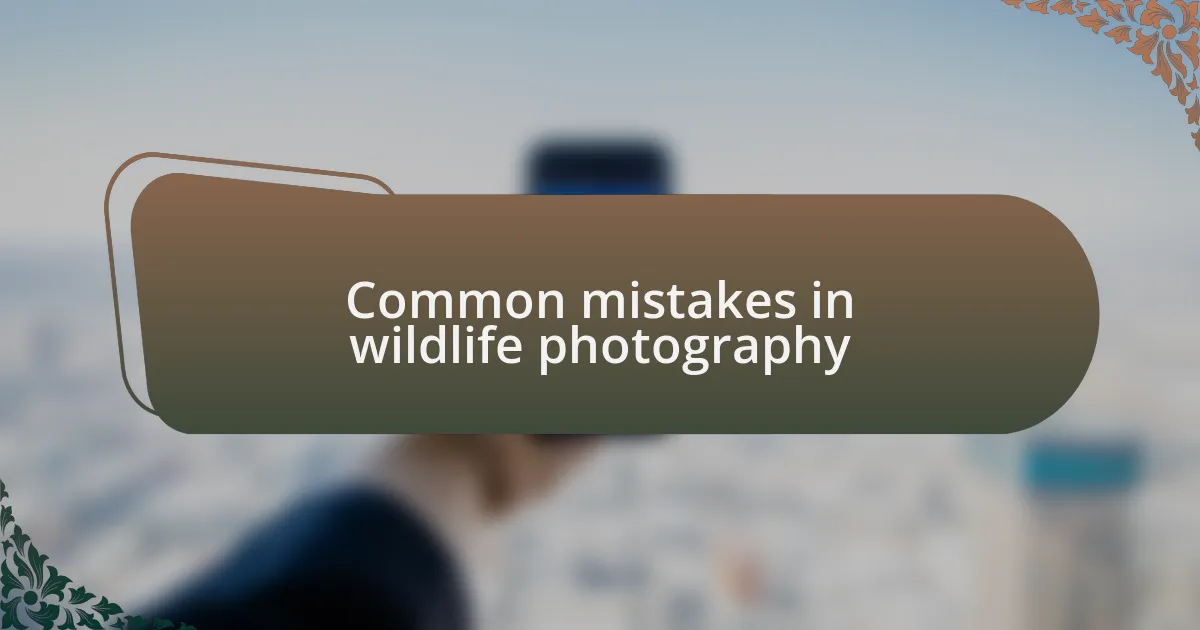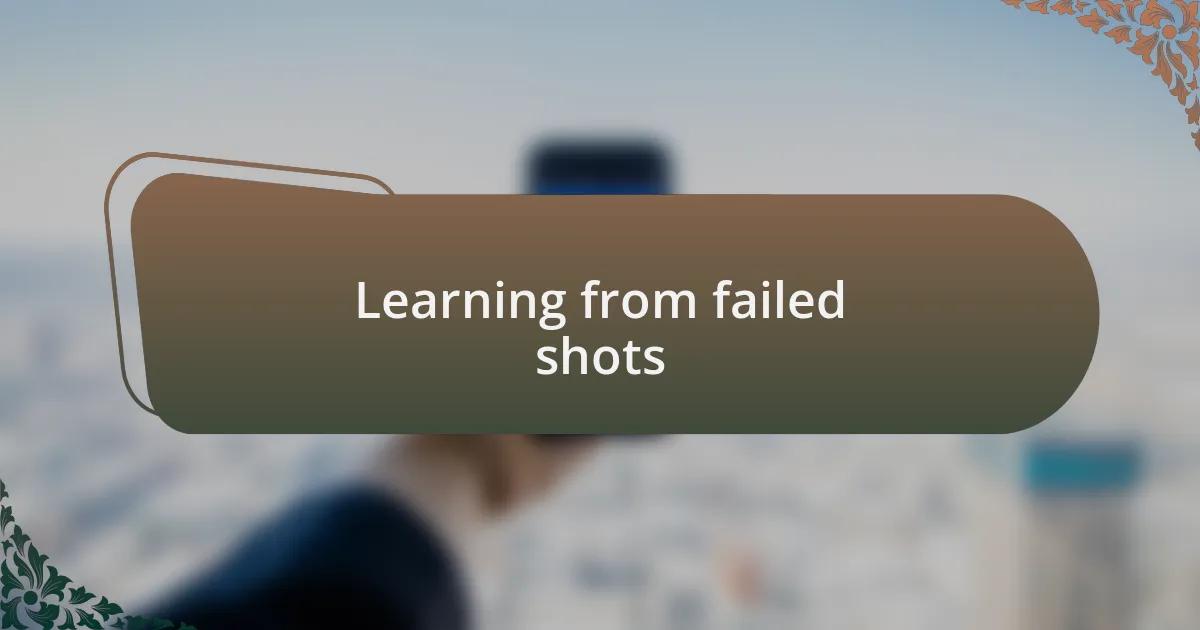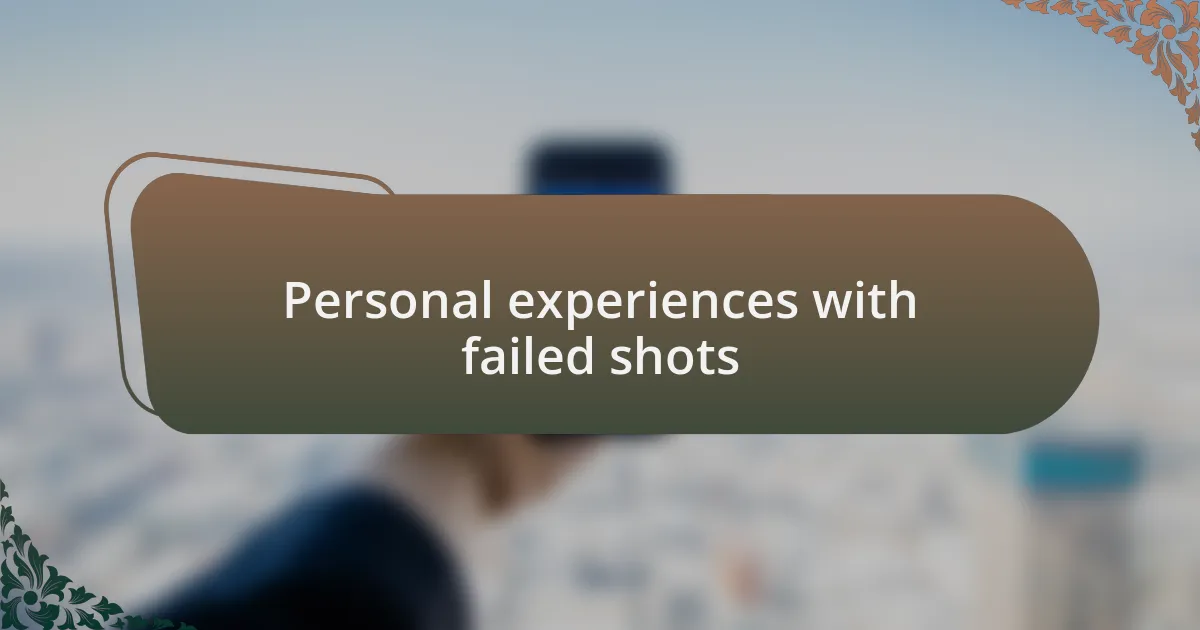Key takeaways:
- Wildlife photography requires patience, understanding of animal behavior, and a commitment to environmental respect.
- Challenges include unpredictability of animals and the need for quick adaptability to changing lighting conditions.
- Common mistakes involve neglecting camera settings, poor composition, and failing to anticipate animal behavior.
- Learning from failed shots can enhance skills and foster a deeper appreciation for wildlife photography.

Introduction to wildlife photography
Wildlife photography is much more than simply capturing images of animals; it’s about telling their stories and immersing oneself in their natural behaviors. I still remember my first encounter with a herd of elephants at a watering hole. I had my camera ready but was so captivated by their grace and interaction that I forgot to click for a moment. Have you ever found yourself so absorbed in a scene that capturing it felt secondary?
This genre of photography demands patience and understanding of animal behavior. I’ve spent hours hiding in bushes, waiting quietly, observing the intricate dynamics of the wild. It’s a reminder that each moment in nature is fleeting and can often evaporate before we can catch it. Isn’t it fascinating how sometimes, the anticipation of the perfect shot leads to unexpected discoveries?
Moreover, wildlife photography invites us to respect our environment and the creatures within it. I often feel a mix of excitement and responsibility while shooting, knowing that I’m portraying these magnificent beings to the world. It raises the question: how can we use our art to inspire a deeper appreciation and conservation of wildlife? Each click is not just about the image; it’s about evoking emotion and raising awareness.

Challenges in wildlife photography
One of the biggest challenges in wildlife photography is the unpredictability of animals. The moments that you hope to capture can vanish in an instant. There was a time when I was poised to photograph a magnificent lion during a sunset, but the moment I pressed the shutter, he turned away, leaving me with an image of an empty savanna instead. Have you ever experienced that heart-sinking feeling after missing a perfect opportunity?
Lighting plays a crucial role as well, often changing when least expected. I recall a morning shoot where the sun was just right, illuminating a group of grazing deer. Then, in a blink, clouds rolled in, altering the scene entirely. It made me realize how essential it is to adapt quickly and be ready for anything; this malleability defines our success or failures in capturing wildlife’s essence.
Additionally, there’s the ethical responsibility we bear as wildlife photographers. It’s tempting to push closer for that incredible shot, yet I often remind myself of the impact on the animals. During one encounter with a delicate bird, I stayed a respectful distance away, valuing the bird’s comfort over my need for proximity. In moments like these, I ponder: what stories are we willing to leave untold for the sake of preserving the wild’s integrity? Striking that balance can be one of the most demanding aspects of our craft.

Common mistakes in wildlife photography
One common mistake that many wildlife photographers make is being too eager to capture the shot without considering the settings on their camera. I remember rushing to photograph a vibrant blue jay perched on a branch, only to realize later that I had forgotten to adjust my ISO from a night shoot. The image turned out grainy, a bitter reminder of the need for careful preparation. How often do we overlook the basics in our excitement?
Poor composition can also sabotage a potentially stunning photo. I once aimed for a striking profile of a charging elephant, but my framing left too much empty space around it, diluting the power of the moment. Asking yourself, “What story is this photo telling?” can transform a missed opportunity into a learning experience. Are we capturing the essence of our subject or simply snapping a nice image?
Lastly, failing to anticipate animal behavior is a pitfall that can lead to disappointing results. I distinctly recall a day spent waiting for a family of otters to emerge from their den, only to find out later that I’d positioned myself too close to their escape route. The moment they dashed in the opposite direction, I understood the importance of observing and respecting their natural patterns. Have you ever found yourself caught off guard by the very subject you aimed to capture? It’s in those moments that we realize the depth of our connection to wildlife—and the value of patience.

Learning from failed shots
Learning from unsuccessful shots is really an opportunity dressed in the guise of disappointment. I recall a day in the wetlands, poised to capture a flock of geese taking flight at sunrise. As I pressed the shutter, the autofocus missed entirely, leaving a blurred mess. It stung, but it pushed me to refine my understanding of natural lighting and the importance of manual focus in low-light conditions. Have you ever had a moment like that, where frustration turned into a pivotal learning point?
There’s a profound lesson in framing your subject correctly. One time, I spotted a majestic stag in the fall, its antlers gilded by the golden leaves surrounding it. I got so caught up in the moment that I didn’t adjust my angle, and instead of a compelling portrait, I received a mediocre shot with distracting branches in the foreground. The experience left me reflecting on how critical it is to engage with the environment around my subject. How often have we rushed the shot and lost the chance for a masterpiece?
Lastly, the emotional weight of a failed wildlife photo can be surprisingly transformative. I sat in silence for hours, waiting for a rare glimpse of a snow leopard. Just as it appeared, I fumbled my camera, missing the moment entirely. The frustration was overwhelming, yet it taught me about mindfulness and preparedness. It’s a poignant reminder: every disappointment can teach us something invaluable, if we choose to learn from it. Have you ever had a moment where you felt the weight of your missed shots, only to emerge more determined?

Techniques for improving wildlife shots
When it comes to improving wildlife shots, honing your timing can be the difference between a fleeting moment and a captivating image. I remember a time I was waiting for a heron to catch a fish. I had positioned myself perfectly, but I wasn’t ready with my camera settings. As the heron lunged, I froze, only to capture an empty splash. This taught me the importance of pre-setting my camera in anticipation of the action. How often do we underestimate the split-second decisions that can turn a missed opportunity into a stunning shot?
Another effective technique is understanding the behavior of your subjects. I once spent an afternoon observing a family of foxes. By studying their interactions and routines, I was finally able to anticipate when they would dart out of their den. That foreknowledge allowed me to capture a heartwarming moment of play, one that I still cherish. Engaging with the animal’s world can make a profound difference—have you ever taken the time to simply watch before you shoot?
Lastly, I can’t stress enough the value of practicing patience. There was an instance when I was out for hours hoping to capture a golden eagle in flight, only to come home empty-handed. Yet, that experience instilled in me a deeper appreciation for the process. Each sit, regardless of the outcome, increases your chances of eventual success. How many times have we prematurely packed up our gear before the magic happens?

Personal experiences with failed shots
I recall a time when I set out to capture photos of a majestic moose during the golden hour. Standing quietly near a lake, I thought I had everything under control. However, just as I pressed the shutter, a sudden gust of wind shook my tripod, and the resulting blur made my heart sink. That day, I learned how fragile our plans can be in wildlife photography. Have you ever experienced a moment that seemed perfect until an unforeseen element turned it upside down?
There was another occasion when I aimed to photograph a family of deer grazing at dawn. I had my camera ready, but my excitement got the best of me. I accidentally clicked the shutter while adjusting my lens, and all I captured was a snapshot of the grass. As frustrating as it was, I realized that being overly eager can sometimes sabotage our best efforts. Have you ever rushed a shot only to be reminded that patience and precision often yield better results?
One memory that stands out is my attempt to capture a hummingbird hovering around a flower. I was so focused on getting the exposure just right that I didn’t notice my settings were off. When I reviewed the images, the hummingbird was a mere blur in all my shots. This experience reinforced the importance of balancing technical settings with spontaneity. It’s funny how even our failures can cultivate growth, isn’t it?